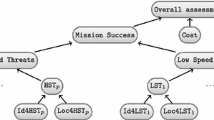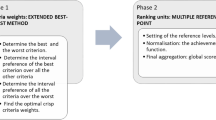Abstract
This paper presents a new approach for selecting suppliers of products or services, specifically with respect to complex decisions that require evaluating different business characteristics to ensure their suitability and to meet the conditions defined in the recruitment process. To address this type of problem, this study presents the multi-person multi-criteria induced ordered weighted average distance (MP-MC-IOWAD) operator, which is an extension of the OWA operators that includes the notion of distances to multiple criteria and expert valuations. Thus, this work introduces new distance measures that can aggregate the information with probabilistic information and consider the attitudinal character of the decision maker. Further extensions are developed using probabilities to form the induced probabilistic ordered weighted average distance (IPOWAD) operator. An example in the management of insurance policies is presented, where the selection of insurance companies is very complex and requires the consideration of subjective criteria by experts in decision making.
Similar content being viewed by others
References
Aggarwal M (2015) Generalized compensative weighted averaging aggregation operators. Comput Ind Eng 87:81–90
Alfaro-García VG, Merigó JM, Gil-Lafuente AM, Kacprzyk J (2018) Logarithmic aggregation operators and distance measures. Int J Intell Sys 33:1488–1506
Avilés-Ochoa E, León-Castro E, Pérez-Arellano LA, Merigó JM (2018) Government transparency measurement through prioritized distance operators. J Intell Fuzzy Syst 34:2783–2794
Bai C, Dhavale D, Sarkis J (2014) Integrating Fuzzy C-Means and TOPSIS for performance evaluation: an application and comparative analysis. Expert Syst Appl 41(9):4186–4196
Beliakov G, Pradera A, Calvo T (2007) Aggregation functions: a guide for practitioners. Springer, Berlin
Belles-Sampera J, Merigó JM, Guillén M, Santolino M (2013) The connection between distortion risk measures and ordered weighted averaging operators. Insur Math Econ 52:411–420
Blanco-Mesa F, Merigó JM, Kacprzyk J (2016) Bonferroni means with distance measures and the adequacy coefficient in entrepreneurial group theory. Knowl Based Syst 111:217–227
Blanco-Mesa F, Merigó JM, Gil-Lafuente AM (2017) Fuzzy decision making: a bibliometric-based review. J Intell Fuzzy Syst 32:2033–2050
Blanco-Mesa F, León-Castro E, Merigó JM (2018) Bonferroni induced heavy operators in ERM decision-making: a case on large companies in Colombia. Appl Soft Comput 72:371–391
Brans JP, Vincke P (1985) A preference ranking organization method: the PROMETHEE method for MCDM. Manag Sci 31(6):647–656
Casanovas M, Torres-Martínez A, Merigó JM (2015) Decision making processes of non-life insurance pricing using fuzzy logic and OWA operators. Econ Comput Econ Cybern Stud Res 49(2):169–188
Casanovas M, Torres-Martínez A, Merigó JM (2016) Decision making in reinsurance with induced OWA operators and Minkowski distances. Cybern Syst 47(6):460–477
Chen S, Mu ZM, Zeng SZ (2015) Atanassov’s intuitionistic fuzzy decision making with probabilistic information and distance measure. J Intell Fuzzy Syst 28(1):317–325
Dursun M, Karsak EE (2010) A fuzzy MCDM approach for personnel selection. Expert Syst Appl 37(6):4324–4330
Emrouznejad A, Marra M (2014) Ordered weighted averaging operators 1988–2014: a citation based literature survey. Int J Intell Syst 29:994–1014
Engemann KJ, Filev DP, Yager RR (1996) Modelling decision making using immediate probabilities. Int J Gen Syst 24:281–294
Figueira J, Greco S, Ehrgott M (2005) Multiple criteria decision analysis: state of the art surveys. Springer, Boston
Gil-Aluja J (1999) Elements for a theory of decision in uncertainty. Kluwer Academic Publishers, Dordrecht
Grabisch M, Marichal JL, Mesiar R, Pap E (2011) Aggregation functions: means. Inf Sci 181:1–22
Hamming RW (1950) Error-detecting and error-correcting codes. Bell Syst Tech J 29:147–160
He XR, Wu YY, Yu D, Merigó JM (2017) Exploring the ordered weighted averaging operator knowledge domain: a bibliometric analysis. Int J Intell Syst 32(11):1151–1166
Kacprzyk J, Yager RR, Merigó JM (2019) Towards human centric aggregation via the ordered weighted aggregation operators and linguistic data summaries: a new perspective on Zadeh’s inspirations. IEEE Comput Intell Mag 14(1):16–30
Karayiannis N (2000) Soft learning vector quantization and clustering algorithms based on ordered weighted aggregation operators. IEEE Trans Neural Netw 11:1093–1105
Kaufmann A (1975) Introduction to the theory of fuzzy subsets. Academic Press, New York
Laengle S, Loyola G, Merigó JM (2017) Mean-variance portfolio selection with the ordered weighted average. IEEE Trans Fuzzy Syst 25(2):350–362
León-Castro E, Avilés-Ochoa E, Merigó JM, Gil-Lafuente AM (2018a) Heavy moving averages and their application in econometric forecasting. Cybern Syst 49:26–43
León-Castro E, Avilés E, Merigó JM (2018b) Induced heavy moving averages. Int J Intell Syst 33(9):1823–1839
Liang G-S (1999) Fuzzy MCDM based on ideal and anti-ideal concepts. Eur J Oper Res 112(3):682–691
Liu HC, You JX, You XY (2014) Evaluating the risk of healthcare failure modes using interval 2-tuple hybrid weighted distance measure. Comput Ind Eng 78:249–258
Meng FY, Zhang Q (2014) Induced continuous Choquet integral operators and their application to group decision making. Comput Ind Eng 68:42–53
Merigó JM, Casanovas M (2011a) Decision-making with distance measures and induced aggregation operators. Comput Ind Eng 60(1):66–76
Merigó JM, Casanovas M (2011b) A new Minkowski distance based on induced aggregation operators. Int J Comput Intell Syst 4(2):123–133
Merigó JM, Casanovas M (2011c) Induced aggregation operators in the Euclidean distance and its application in financial decision making. Expert Syst Appl 38(6):7603–7608
Merigó JM, Gil-Lafuente AM (2010) New decision-making techniques and their application in the selection of financial products. Inf Sci 180(11):2085–2094
Merigó JM, Yager RR (2013) Generalized moving averages, distance measures and OWA operators. Int J Uncertain Fuzziness Knowl Based Syst 21:533–559
Merigó JM, Xu Y, Zeng S (2013) Group decision making with distance measures and probabilistic information. Knowl Based Syst 40:81–87
Merigó JM, Casanovas M, Zeng SZ (2014) Distance measures with heavy aggregation operators. Appl Math Model 38(13):3142–3153
Merigó JM, Palacios-Marqués D, Soto-Acosta P (2017) Distance measures, weighted averages, OWA operators and Bonferroni means. Appl Soft Comput 50:356–366
Noor-E-Alam M, Lipi TF, Hasin AAM, Ullah AMMS (2011) Algorithms for fuzzy multi expert multi criteria decision making (ME-MCDM). Knowl Based Syst 24(3):367–377
Önüt S, Kara SS, Işik E (2009) Long term supplier selection using a combined fuzzy MCDM approach: a case study for a telecommunication company. Expert Syst Appl 36(2):3887–3895
Qi XW, Liang CY, Zhang JL (2015) Generalized cross-entropy based group decision making with unknown expert and attribute weights under interval-valued intuitionistic fuzzy environment. Comput Ind Eng 79:52–64
Scherger V, Terceño A, Vigier H (2017) The OWA distance operator and its application in business failure. Kybernetes 46(1):114–130
Shannon CE (1948) A mathematical theory of communication. Bell Syst Tech J 27:379–423
Su WH, Zhang C, Zeng SZ (2015) Uncertain induced heavy aggregation distance operator and its application to decision making. Cybern Syst 46(3–4):172–187
Torra V (1997) The weighted OWA operator. Int J Intell Syst 12:153–166
Tsao CT (2006) A fuzzy MCDM approach for stock selection. J Oper Res Soc 57(11):1341–1352
Ulutagay G, Kantarci S (2015) An extension of fuzzy L-R data classification with fuzzy OWA distance. Int J Intell Syst 30(9):1006–1020
Vizuete E, Merigó JM, Gil-Lafuente AM, Boria S (2015) Decision making in the assignment process by using the Hungarian algorithm with the OWA operator. Technol Econ Dev Econ 21(5):684–704
Wei GW, Zhao XF, Lin R (2013) Some hybrid aggregating operators in linguistic decision making with Dempster–Shafer belief structure. Comput Ind Eng 65:646–651
Xian S, Sun W (2014) Fuzzy linguistic induced Euclidean OWA distance operator and its application in group linguistic decision making. Int J Intell Syst 29(5):478–491
Xu ZS (2012) Fuzzy ordered distance measures. Fuzzy Optim Decis Mak 11:73–97
Xu ZS, Chen J (2008) Ordered weighted distance measures. J Syst Sci Syst Eng 17:432–445
Xu ZS, Da QL (2003) An overview of operators for aggregating the information. Int J Intell Syst 18:953–969
Yager RR (1988) On ordered weighted averaging aggregation operators in multicriteria decision-making. IEEE Trans Syst Man Cybern 18(1):183–190
Yager RR (1993) Families of OWA operators. Fuzzy Sets Syst 59:125–148
Yager RR (2003) Induced aggregation operators. Fuzzy Sets Syst 137(1):59–69
Yager RR, Filev DP (1999) Induced ordered weighted averaging operators. IEEE Trans Syst Man Cybern B 29(2):141–150
Yager RR, Engemann KJ, Filev DP (1995) On the concept of immediate probabilities. Int J Intell Syst 10:373–397
Yager RR, Kacprzyk J, Beliakov G (2011) Recent developments on the ordered weighted averaging operators: theory and practice. Springer, Berlin
Yusoff B, Merigó JM, Ceballos D (2017) OWA-based aggregation methods in multi-expert MCDM model. Econ Comput Econ Cybern Stud Res 51(2):211–230
Zeng SZ (2013) Decision making with the uncertain IMOWAD operator. Kybernetes 42:785–799
Zeng SZ, Su W (2012) Linguistic induced generalized aggregation distance operators and their application to decision making. Econ Comput Econ Cybern Stud Res 46:155–172
Zeng SZ, Merigó JM, Su WH (2013) The uncertain probabilistic OWA distance operator and its application in group decision making. Appl Math Model 37(9):6266–6275
Zeng SZ, Merigó JM, Palacios-Marqués D, Jin HH, Gu FJ (2017) Intuitionistic fuzzy induced ordered weighted averaging distance operator and its application to decision making. J Intell Fuzzy Syst 32(1):11–22
Zhou LG, Chen HY, Liu JP (2013) Continuous ordered weighted distance measure and its application to multiple attribute group decision making. Group Decis Negot 22:739–758
Zhou LG, Wu JX, Chen HY (2014) Linguistic continuous ordered weighted distance measure and its application to multiple attributes group decision making. Appl Soft Comput 25:266–276
Zhou LG, Jin FF, Chen HY, Liu JP (2016) Continuous intuitionistic fuzzy ordered weighted distance measure and its application to group decision making. Technol Econ Dev Econ 22(1):75–99
Acknowledgements
We would like to thank the associate editor and the anonymous reviewers for valuable comments that have significantly improved the quality of the paper. Support from the MAPFRE Foundation, the Fondecyt Regular Programme of the Chilean Government and the European Commission through the project PIEF-GA-2011-300062, is gratefully acknowledged.
Author information
Authors and Affiliations
Corresponding author
Ethics declarations
Conflict of interest
The authors declare that they do not have any conflicts of interest.
Ethical approval
This article does not contain any studies with human participants performed by any of the authors.
Additional information
Communicated by V. Loia.
Publisher's Note
Springer Nature remains neutral with regard to jurisdictional claims in published maps and institutional affiliations.
Rights and permissions
About this article
Cite this article
Casanovas, M., Torres-Martínez, A. & Merigó, J.M. Multi-person and multi-criteria decision making with the induced probabilistic ordered weighted average distance. Soft Comput 24, 1435–1446 (2020). https://doi.org/10.1007/s00500-019-03977-6
Published:
Issue Date:
DOI: https://doi.org/10.1007/s00500-019-03977-6




